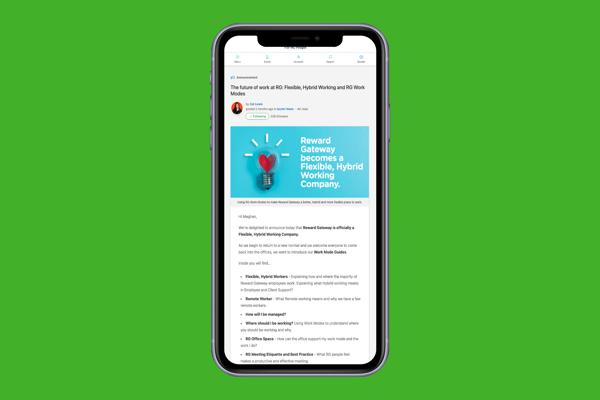The past year or so has flown by so quickly, it's hard to remember what day it is sometimes. But for me, I know that on Fridays, it’s “survey prep day.”
It’s the first in a series of tactics that I’ve put in place as our nearly 500 Reward Gateway employees begin the transition of returning to the office.
This hasn’t been easy. I’ve spent many months to this point planning for this particular moment, and I know that I could not be as far along as we are without the right tools to help me during this project. We’ve worked hard to put in place systems to survey and communicate with our employees, while maintaining a focus on wellbeing and reward and recognition. It’s my goal to make sure our return to the office is as successful as the transition to working from home was.
When I think about it, I see the technology revolution in HR accelerating and I am glad that I have the tools I have to help me make RG a better place to work. This revolution continues to change the way HR leaders connect, recognize and support their people. Let’s dive into the new world of HR technology:
Out with the old, in with the new
Just as the pandemic changed where we worked, it also changed how we interact with digital tools. HR professionals have had to adapt their approaches along the way, and technology’s capabilities are not only more apparent but also more accessible.
Earlier on in the pandemic, you may have been recognizing your employees for different reasons, or you adapted your communication style but you’re finding that these methods aren’t working anymore.
It’s up to us as HR leaders to fully understand the power of HR tools and how we can keep our engagement strategy fresh, relevant and fair for all employees, especially as we continue navigating the War for Talent. Let’s walk through some examples to bring this to life:
|
Old method |
New method |
|
Bi-annually surveying employees to measure employee engagement or other large metrics. |
Frequently polling employees to keep a pulse on employee sentiment, return to work thoughts and how the People Team is helping them feel more at ease. |
|
Communicating global updates to the entire company to keep everyone in the loop at the same time. |
Tailoring communications to different locations, understanding that different offices may be in different stages of returning to work, even if they are under the same company. |
|
Recognizing efforts made as employees quickly adjusted to a remote work environment, such as completing a project with a virtual team for the first time. |
Rewarding behaviors, such as getting a COVID-19 vaccine or offering incentives for modeling good in-office behaviors. |
Making employee surveys simple
Back to my survey. We were preparing this particular survey to see when our employees think they want to return to the office, rather than being based at home.
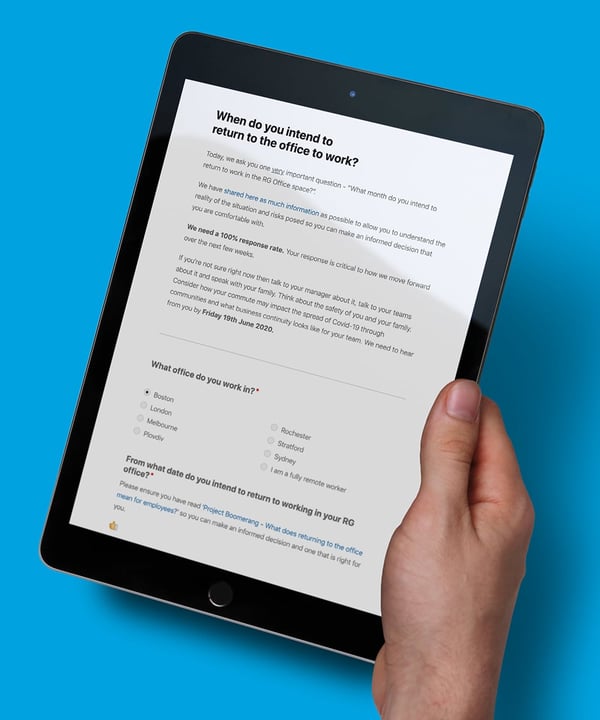
It was a simple survey asking them to select a month as part of our return to work headcount planning. Like all things at RG, I’m grateful that we can use our own tools. The employee survey will run on our survey platform, taking a multi-channel approach to integrate into a sent email, appearing as a prompt on boom!, our employee engagement platform, and will count as we get replies.
This data is vital as we begin the difficult process of bringing people back into work, safely and with confidence.
Facilitating critical employee communications
But before that survey could go out, our employees needed to understand its context. It’s not enough to ask them a question when they’re unsure what "back to the office" would look like. So before the survey went out, we shared a comprehensive blog on what returning to each office would look like. It was a lengthy read, but the detail was necessary so all could visualize what it would be like to return.
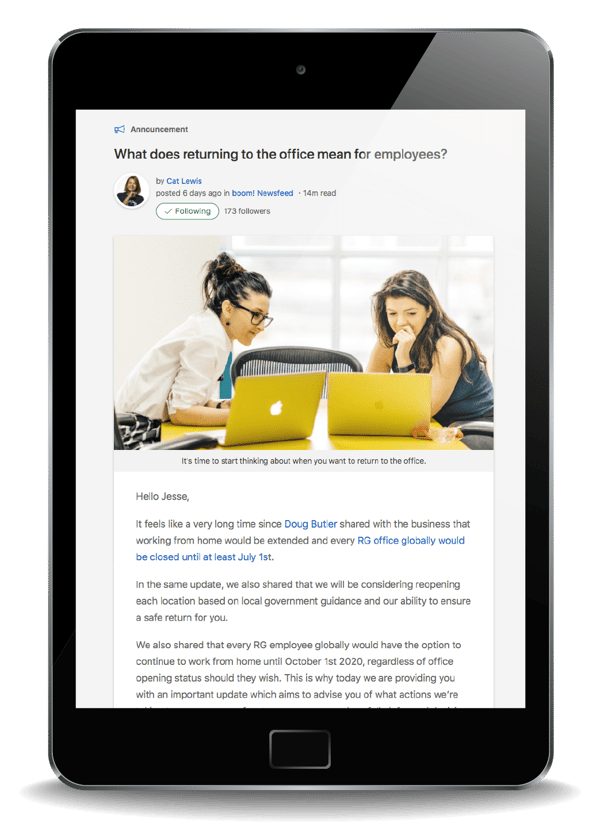
Even with part of our global teams fast asleep in Australia upon launch, the blog received nearly 300 views the morning after posting. We decided on a blog so that employees could ask questions in real-time and get fast answers – our point person on this was Cat Lewis, our Head of Global Engagement and Internal Communications, who was monitoring the comment thread in real-time since she was notified as they came in.
The comments become a Q&A, so my colleagues and I can answer questions or respond to comments the moment they come in from our people.
This reassures me that our employees are really understanding of what we’re trying to achieve as a business.
While we’re pleased to see high engagement with our employee communications tools, I knew this would gain extra views since we used our "Announcement" tool to ensure the first thing employees see when they log into boom! is the announcement, and it pushes this notification to a corresponding employee engagement app, too.
This means we know that people will read it, driving up awareness and usage and to give my team confidence that things will be read and understood.
Fast-forward a few months later, and we took all of the employee feedback we received to create a flexible, hybrid working guide for our people. We changed up our communication approach and mapped out eight options for employees to follow on any given day, whether they’re "plugged in" or in a "1-to-1." Instead of ambiguous timelines, we gave people the option for flexible work – to come into the office when they’d like and to work remotely on days where they need to be heads down.
There was even a guide for each office location, making sure the content was personalized, tailored and relevant to our global employees.
Putting a new employee wellbeing process in place
"Wellbeing," a word that is central to every aspect of the HR world of 2020. As an employer with employee wellness at the heart of what we do, we have been helping our employees get access to best-in-class tools like a wellbeing coach, a respected EAP program in each geo, our own Wellbeing Center that delivers hundreds of articles and videos on-demand, as well as enabling them to access their wellbeing allowance benefit (a cash sum) during the lockdown period.
 Now our employees love this benefit – they can use the money for anything from a new treadmill to language lessons or sleep aids. But the process now is that they go and fill out a Google form on our platform, which my team then has to manually process.
Now our employees love this benefit – they can use the money for anything from a new treadmill to language lessons or sleep aids. But the process now is that they go and fill out a Google form on our platform, which my team then has to manually process.
For future wellbeing windows, we’ll be able to use our own benefits automation product to manage the benefit across all our geographies.
So when we tell staff they can apply for this year’s allowance, we’ll greatly reduce the admin typically needed for this much-loved benefit by as much as 50%! We’ll also have better reporting on how much employees are requesting and what they are using it for, which will feed into the Total Reward Statements we have just launched globally. I’m happy that this means that our People team will have to answer fewer questions on how much someone has left to spend.
Although COVID-19 forced many of us to work from home, it also allowed us to work smarter, and think about connecting colleagues across the globe, and made their interactions with our People team faster, better and with less friction.
Reward and recognition, at the heart of it all
As an HR leader, I am seeing amazing work being done by the Sales team in working with future new clients, our Client Success team partnering with existing clients and helping make their worlds better, and then I am seeing our Engineers and Product teams innovate and make everything smoother and faster.
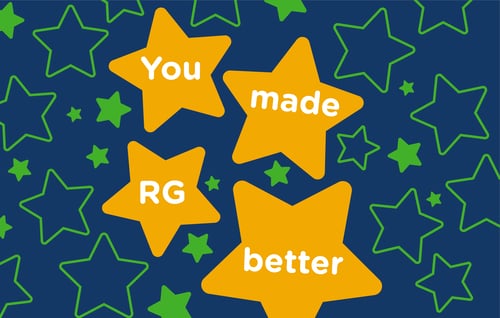
And I want to recognize them as I see that, and to thank them in meaningful and visible ways, to amplify that and to democratize the impact and value of employee recognition.
Hybrid working can sometimes mean work might not be as visible as it was before, so selfishly this ensures that our employees continue to receive recognition from colleagues and managers.
I can see at a glance who is receiving recognition and what teams may need a little extra attention through our data analytics platform, which links up directly with our reward and recognition tools for a full picture.
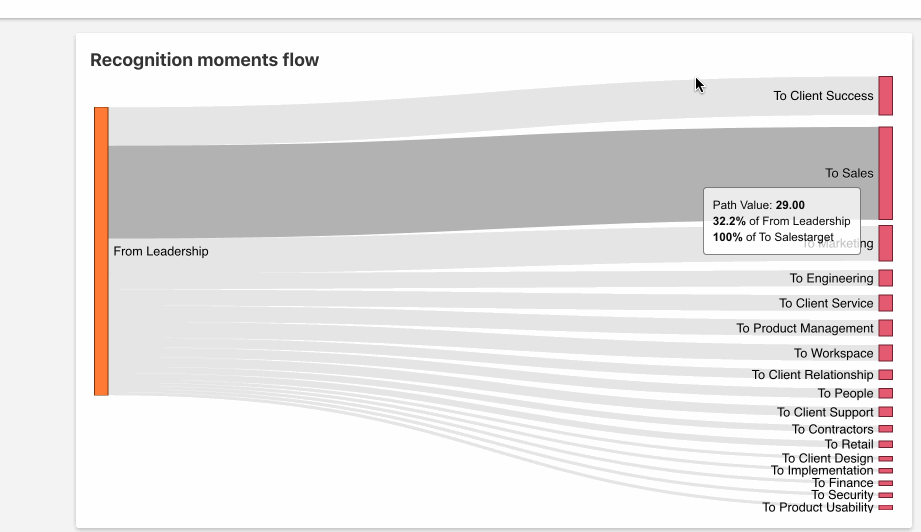
Our employees love to be recognized, and I need to be able to ensure that this continues whether our people are at home, a local coffee shop or the office. This includes thanking those who are working on the project. Sharing my thanks now, will get me extra credit with the team when I ask them to dig deep and help me.
Being the People Leader at Reward Gateway is a blessing, and I feel thankful that I can use all of our tools to make my life easier and make the life of the People team easier and most importantly the world of everyone at RG even better going forwards.
If you have any questions about how RG can help you better connect, recognize and support your people, reach out to us today.

 Robert Hicks
Robert Hicks


